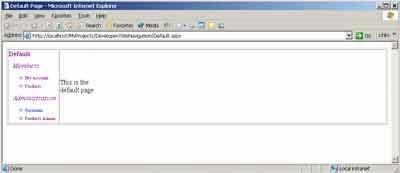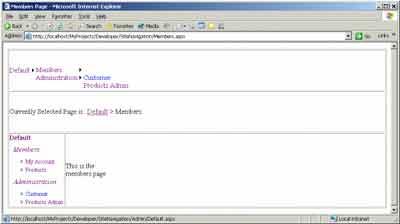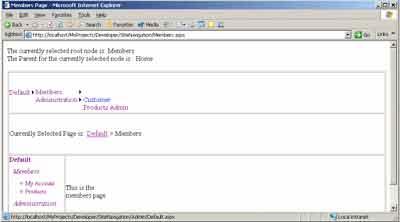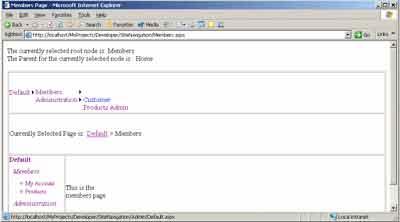
·您现在的位置: 云翼网络 >> 文章中心 >> 网站建设 >> 网站建设开发 >> ASP.NET网站开发 >> 在ASP.NET 2.0中使用页面导航控件
- 标签 Attribute
- 值类型和引用类型在hashtable里面存取的性能比较
- 在ASP.Net 2.0中实现多语言界面的方法
- 用于MySql的SqlHelper
- vs2013中将原来在iis express中的网站转到iis中时,报“无法在web服务器上调试”的解决方法
- jQuery的ajax 方法提交多个对象数组问题 C# traditional $.param
- ASP.Net中防止页面刷新重复提交的几种方法
- ASP.NET 页生命周期
- 页面显示的数据为过时的数据,要清cookie才行
- 一个简单的Webservice的demo(中)_前端页面调用
- VB.Net遍历已安装的程序卸载信息
- 基于Metronic的Bootstrap开发框架经验总结(9)--实现Web页面内容的打印预览和保存操作
- c#文本框只能输入数字
- 使用FindControl(id)查找控件 返回值都是Null的问题
- 看看Parallel中高度封装的三个方法,Invoke,For和ForEach
- 大话二进制,八进制,十进制,十六进制之间的转换
- 何时.NET中AppDomain会回收?
- C#中this的作用
- ASP.NET发送电子邮件
- C# sogou地图API应用总结(二)
- [渣译文] SignalR 2.0 系列:SignalR的服务器广播
- DotNET知识点总结四(笔记整合)
- 网站性能优化:动态缩略图技术实现思路
- ASP.Net项目出错处理方法汇总
- ASP.NET使用FileUpload上传文件
- C#程序集系列07,篡改程序集
- asp.net中怎样调用存储过程和存储过程的写法
- extern外部方法使用C#简单例子
- (转)Asp.net的HttpCookie写入汉字读取时为乱...
- [视频]vs2005入门之变量的概念\声明\特性\常见错误
在ASP.NET 2.0中使用页面导航控件
文/廖煜嵘
几乎每个网站里,为了方便用户在网站中进行页面导航,都少不了使用页面导航控件。有了页面导航的功能,用户可以很方便地在一个复杂的网站中进行页面之间的跳转。在以往的WEB编程中,要写一个好的页面导航功能,并不是那么容易的,也要使用一些技巧。而在asp.net 2.0中,为了方便进行页面导航,新增了一个叫做页面导航控件sitemapdatasource,其中还可以绑定到不同的其他页面控件,比如treeview,menu等,十分灵活,使到能很方便地实现页面导航的不同形式,而且还提供了运行时的编程接口,可以以编程的形式动态实现页面导航控件。本文将简单以几个例子来介绍一下在asp.net 2.0中如何实现页面导航。
页面导航的结构和sitemapdatasource控件
在asp.net 2.0中,要实现页面导航,应该先以xml的形式,提供出整个网站的页面结构层次。我们可以编写一个叫web.sitemap的XML文本文件,在该文件中定义出整个要导航页面的结构层次。举例如下:
<?xml version="1.0" encoding="utf-8" ?>
<siteMap>
<siteMapNode title="Default" description="Home" url="Default.aspx" >
<siteMapNode title="Members" description="Members" url="Members.aspx">
<siteMapNode title="My Account" description="My Account" url="MyAccount.aspx" />
<siteMapNode title="PRoducts" description="Products" url="Products.aspx" />
</siteMapNode>
<siteMapNode title="Administration" description="Administration" url="~/Admin/Default.aspx">
<siteMapNode title="Customer" description="Customer Admin" url="~/Admin/Customer/default.aspx" />
<siteMapNode title="Products Admin" description="Products Admin" url="~/Admin/ProductsAdmin.aspx" />
</siteMapNode>
</siteMapNode>
</siteMap>
我们可以看到,其中,web.sitemap文件必须包含根结点sitemap。而且,设置一个父sitemapnode结点,该结点表明是默认的站点首页,在该父sitemapnode结点下,可以有若干个子sitemapnode结点,分别按层次结构代表了网站的各子栏目(留意一下上例中,各个子结点之间的包含关系)。而每一个sitemapnode结点中,有如下若干个属性:
1)URL属性:该属性指出要导航的栏目的地址链接,在web.sitemap中定义中,必须是每个栏目的相对地址。
2)Title属性:该属性指出每个子栏目的名称,显示在页面中。
3)Description属性:该属性指定时,则用户在鼠标移动到该栏目时,出现有关该栏目的相关提示,类似于tooltips属性。
在设计好sitemap属性后,接下来就可以一步步构建页面导航功能了,主要有两个步骤:
1) 向页面中添加sitemapdatasource控件。该控件会自动感应绑定web.sitemap中的内容。
2) 将sitemapdatasource控件绑定到如sitemappath,treeview,menu等控件中,也就是说,将它们的数据源设置为该sitemapdatasource控件。
知道了方法后,我们下面就分别以treeview,menu,sitemappath三种控件为例子,介绍一下如何和sitemapdatasource控件进行配合使用。
先来介绍使用treeview控件和sitemapdatasource 控件配合使用的方法。Treeview树形列表控件十分适合于用来做页面导航,为了能具体说明,我们充分利用asp.net中的masterpage控件,先搭建出一个网站的基本框架架构。
在visual web developer 2005 beta 1中,新建一个网站,之后添加上文的web.sitemap文件,再添加一个名叫Navigation的master类型的页面,代码如下:
<%@ Master Language="C#" %>
<html xmlns="www.w3.org/1999/xhtml" >
<head id="Head1" runat="server">
<title>Master Page</title>
</head>
<body>
<form id="form1" runat="server">
<div>
<table style="width: 100%; height: 100%" border="1">
<tr>
<td style="width: 10%">
<asp:TreeView ID="TreeView1" Runat="server" DataSourceID="SiteMapDataSource1"
ExpandDepth="2" ShowExpandCollapse="False" NodeIndent="10">
<LevelStyles>
<asp:TreeNodeStyle Font-Bold="True" Font-Underline="False"/>
<asp:TreeNodeStyle Font-Italic="True" Font-Underline="False" />
<asp:TreeNodeStyle Font-Size="X-Small" ImageUrl="bullet.gif" Font-Underline="False" />
</LevelStyles>
<NodeStyle ChildNodesPadding="10" />
</asp:TreeView>
</td>
<td style="width: 100px">
<asp:contentplaceholder id="ContentPlaceHolder1" runat="server">
</asp:contentplaceholder>
</td>
</tr>
</table>
<asp:SiteMapDataSource ID="SiteMapDataSource1" Runat="server"/>
</div>
</form>
</body>
</html>
在上面的代码中,其中的TREEVIEW控件中的DATASORUCE属性中,就指定了sitemapdatasource控件,并且在treeview控件中,也定义了不同结点的样式。
在完成了masterpage页面后,就等于已经把网站的模版页建立起来了,接下来就可以新建其他子页面,以继承masterpage页面,并且新建各自页面的内容了。比如,新建一个default.aspx页面,代码如下:
<%@ Page Language="C#" MasterPageFile="Navigation.master" Title="Default Page"%>
<asp:Content ContentPlaceHolderID="ContentPlaceHolder1"
ID="Content1" Runat="Server">
This is the default page
</asp:Content>
可以看到,当建立了模版页后,就可以新建其他的子页面了,只需要在其中的contentplaceholderid中写入不同的内容就可以了。运行起来后,效果如图:

接下来,我们来介绍如何将menu菜单控件和sitemapdatasource 控件配合使用。其中,我们在上面的例子的基础上,在<table style="width: 100%; height: 100%" border="1">下面增加如下代码就可以了,
<tr height="100px">
<td colspan="2" align="left">
<asp:Menu ID="Menu1" Runat="Server"
DataSourceID="SiteMapDataSource1">
</asp:Menu>
</td>
</tr>
其中,我们增加了一个menu控件,其中将其datasourceid属性设定为sitemapdatasource1就可以了,运行如下图,当然,我们可以改变menu控件的显示位置,如可以将其改成垂直样式显示。

而对于我们经常见到的显示出页面当前路径的导航条功能,在asp.net 2.0中也可以轻易实现,我们可以使用其中的sitemappath控件。我们紧接着在上文代码中的menu控件下,增加如下代码:
<tr height="100px">
<td colspan="2" align="left">
Currently Selected Page is:
<asp:SiteMapPath Runat="Server" ID="SiteMapPath1"></asp:SiteMapPath>
</td>
</tr>
要注意的是,只要增加sitemappath控件就可以了,因为它会自动和已经增加的sitemapdatasource控件进行绑定的。我们为了说明问题,另外增加一个页面member.aspx,代码如下:
<%@ Page Language="C#" MasterPageFile="Navigation.master" Title="Members Page"%>
<asp:Content ContentPlaceHolderID="ContentPlaceHolder1" ID="Content1" Runat="Server">
This is the members page
</asp:Content>
运行结果如下:

最后,我们看一下,如何通过编程的方式来获取页面导航中的相关数据。其中,必须引用到的是sitemap类,该类提供了很多相关的方法和属性,最重要的是currentnode属性,它可以指出当前用户正在浏览的是哪一个栏目页面,这用来跟踪用户在网站中的行动轨迹,并进行站点数据统计,有时是很有用的,举例如下:
<%@ Page Language="C#" MasterPageFile="Navigation.master" Title="Members Page"%>
<script runat="Server">
void Page_Load(object sender, EventArgs e)
{
Response.Write("The currently selected root node is: " + SiteMap.CurrentNode.Description + "<br>");
Response.Write("The Parent for the currently selected node is : " +
SiteMap.CurrentNode.ParentNode.Description);
}
</script>
<asp:Content ContentPlaceHolderID="ContentPlaceHolder1" ID="Content1" Runat="Server">
This is the members page
</asp:Content>
在这个例子中,使用程序的方式,得出了用户当前正在浏览的栏目页面,以及该栏目的父栏目的名称,运行结果如下图:
